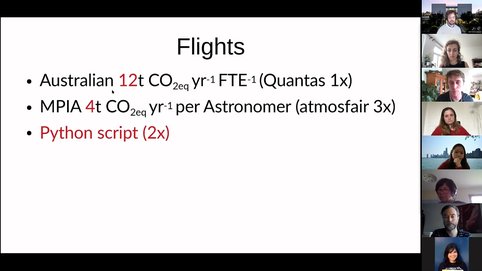Carbon Footprints of Research Projects and Institutes
18 March 2021 10:00 with Clarisse Aujoux and Jan Rybizki
18 Mar 2021 | Time: 10:00 | virtual | Web Seminar | English with automized translation into your language (detailed instructions here)
No registration required.
Speaker: Clarisse Aujoux; Pre-print of the paper; Recording on YouTube: https://youtu.be/LFykQtMBpX0
We present a pioneering estimate of the global yearly greenhouse gas emissions of a large-scale Astrophysics experiment over several decades: the Giant Array for Neutrino Detection (GRAND). The project aims at detecting ultra-high energy neutrinos with a 200,000 radio antenna array over 200,000 km
Speaker: Jan Rybizki; Publication on MPI-A CO2 Assessment; Recording on YouTube: https://youtu.be/bbUoZcFLLQ4
As astronomers of the Max Planck Institute for Astronomy (MPIA) in Heidelberg, Germany, we have assessed our work-related GHG emissions. We have assessed and summarized the MPIA’s research-related emissions for the year 2018, finding that the average MPIA astronomer produced at least 18.1 tCO2e of research-related GHG emissions in that year, a sobering three times the emissions needed for Germany to meet its 2030 goals, set in accordance with the Paris Agreement. We identified the areas in which we produced the most GHG emissions and urge other institutes to conduct their own assessment. Each institute will face a unique set of challenges, depending on its location, funding structure, and fields of research. These challenges can only be addressed once quantified.

